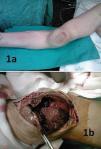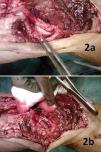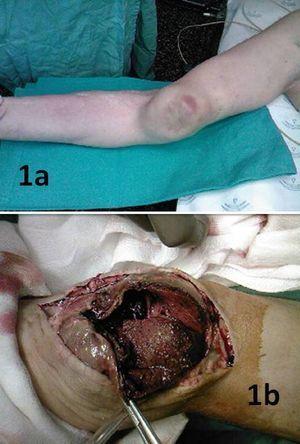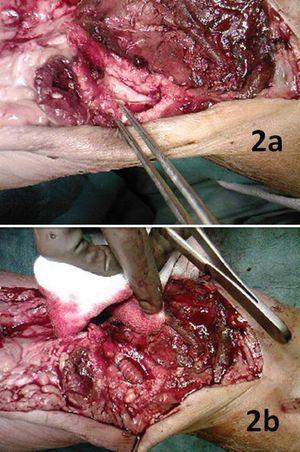To the Editor,
Advances in treating end-stage chronic kidney disease have made vascular access one of the most common interventions for vascular surgeons. As with any other surgical procedure, it is not exempt from complications, and patients may present with thrombosis, haemorrhage, infection, steal syndrome, venous hypertension or long-term formation of pseudoaneurysms. The development of this last condition does not only mean that the fistula has a shorter useful life, it also involves greater risk of graft thrombosis, infection, difficulty in access or even rupture.
We present the case of a giant pseudoaneurysm of an upper-arm autologous arteriovenous fistula, which required surgical treatment to be resolved.
A 61-year-old man, diagnosed with chronic renal failure of unknown origin since 1975, when started on regular haemodialysis. Since then, he has received a total of three kidney transplants, having been a recipient for 20 years. Two years ago, he was included once more on a haemodialysis programme (using a central venous catheter). Other interesting aspects of his medical history were: arterial hypertension, insulin-dependent diabetes mellitus, C virus chronic liver disease and surgical repair of pseudoaneurysm developed on an arteriovenous fistula in the contralateral arm (left).
In the last three years, the patient developed a pulsatile tumour in a previous fistula in the right upper arm, compatible with a pseudoaneurysm. After it sharply increased in size during recent months (Figure 1a), a computerised angiotomography (angio-CT) was requested which showed that axillary and subclavian arteries were permeable, the humeral artery was very calcified and fistula in the flexure of the right forearm with a giant pseudoaneurysm of 63x57mm.
Following these observations, surgery was indicated to close the fistula. We used a cuff on the high upper arm to produce ischaemia and control the bleeding during the opening. We performed a longitudinal incision on the pseudoaneurysm (Figure 1) so that the original path of the humeral artery could be located (Figure 2a) and the humero-humeral bypass was performed with a 6-mm Dacron prosthetic graft. The blood flow towards the limb (Figure 2b) was fully re-established.
Vascular access complications are responsible for 15% of haemodialysis patients’ hospital admissions.1 For that reason, a multidisciplinary approach must be used to detect them early.2 Pseudoaneurysms are relatively uncommon complications, and their incidence is even less in autologous fistulae, compared to those performed with a polytetrafluoroethylene (PTFE) graft.3 In those cases that reach a small size, endovascular treatment (covered stent or thrombin injection) may be enough to try and prolong the vascular access’s life.4 In contrast, for cases such as that described, open surgery is the only effective treatment for avoiding events that require urgent action.
Figure 1.
Figure 2.










